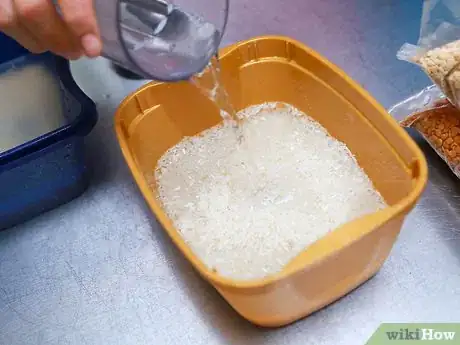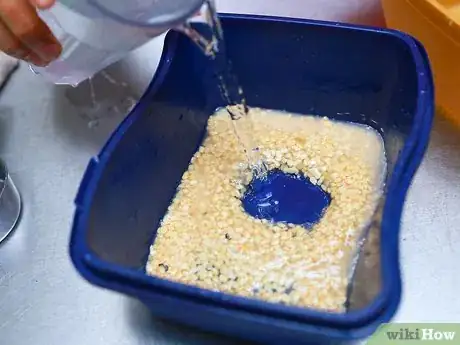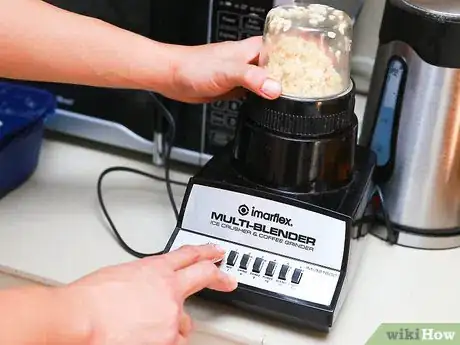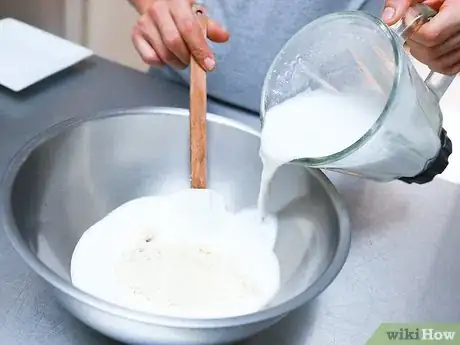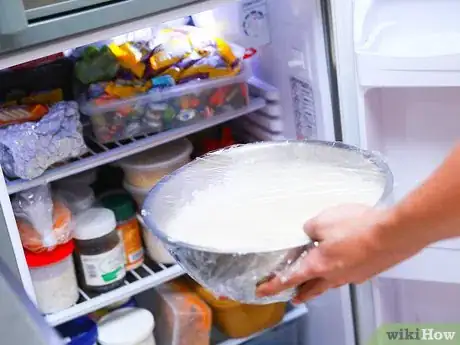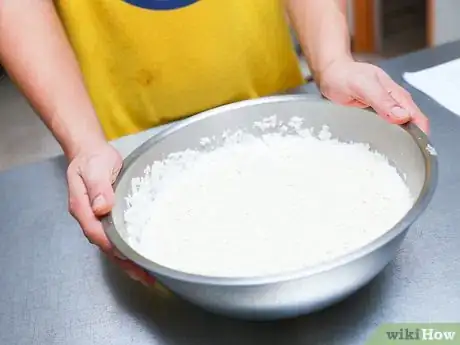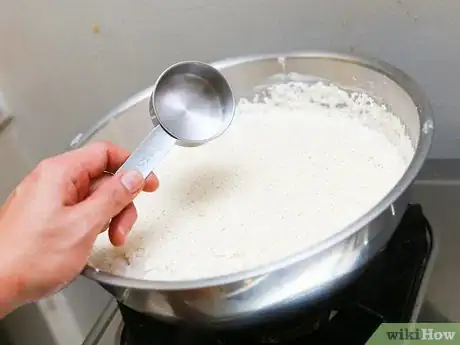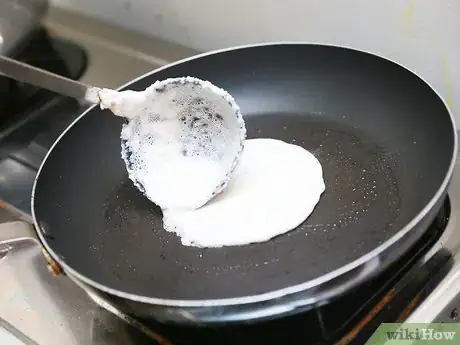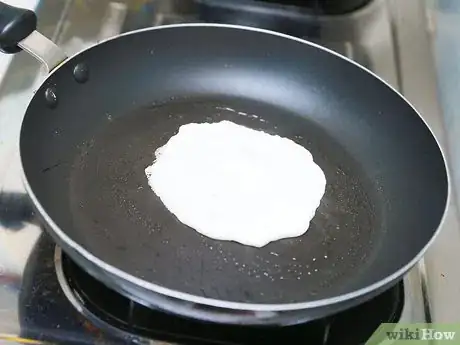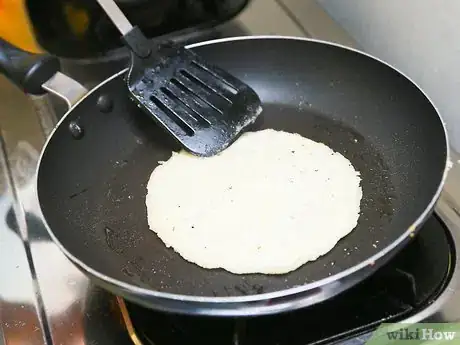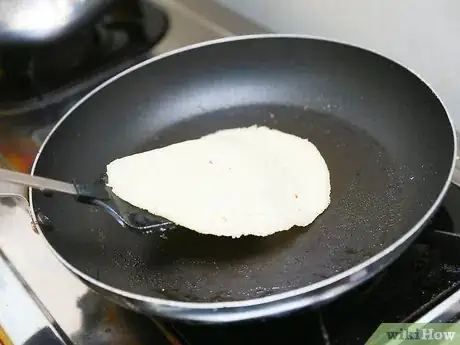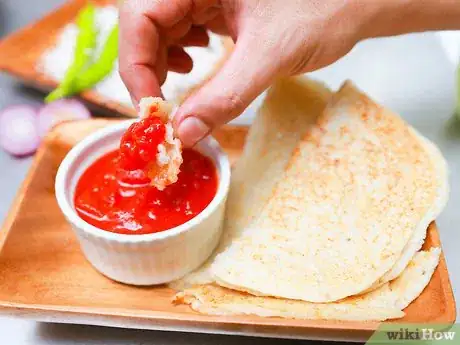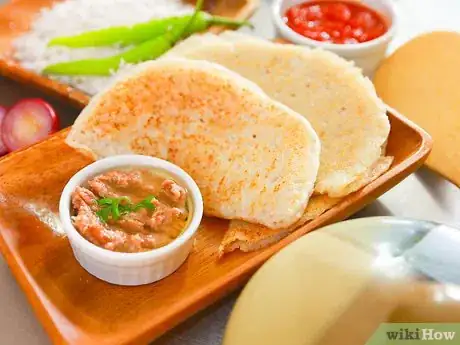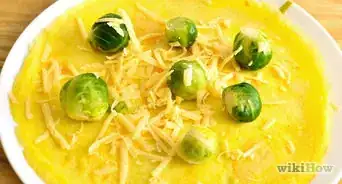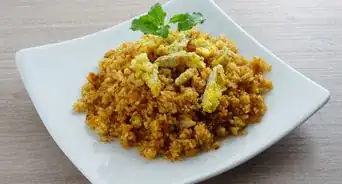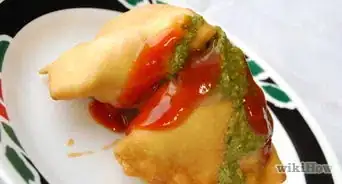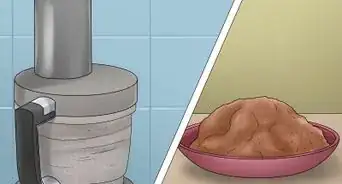This article was co-authored by wikiHow Staff. Our trained team of editors and researchers validate articles for accuracy and comprehensiveness. wikiHow's Content Management Team carefully monitors the work from our editorial staff to ensure that each article is backed by trusted research and meets our high quality standards.
wikiHow marks an article as reader-approved once it receives enough positive feedback. In this case, 85% of readers who voted found the article helpful, earning it our reader-approved status.
This article has been viewed 465,466 times.
Learn more...
Dosas are very thin pancakes usually made from rice and urad dhal (also known as split black lentils or black gram). This crepe-like food of India is very thin and crispy, with a taste similar to sourdough bread. Dosas can be made small, for individuals, or larger, for people to share. They are a good source of protein and are relatively easy to make.
Ingredients
- 2 cups rice, rinsed (recommended 1 cup medium-grained rice, 1 cup parboiled rice)
- 1/2 cup urad dhal, rinsed (split black lentils)
- 1/2 tsp fenugreek seeds (5-7 seeds)
- Filtered water
- 1 tsp salt
Steps
Making the Batter
-
1Soak the rice. After rinsing the rice, place it in a large bowl and cover with water. Ideally, there should be about 2 inches (5 cm) of water above the surface of the rice to allow for absorption. Soak for about 6 hours.
-
2Soak the urad dhal and fenugreek. After rinsing the dahl, place it in a large bowl with the fenugreek seeds and cover with water. Ideally, there should be about 2 inches (5 cm) of water above the surface of the rice to allow for absorption. Soak for about 6 hours.Advertisement
-
3Grind the urad dhal and fenugreek. A wet grinder is the best option for this,[1] but a food processor or blender may work as well. Add the soaked dhal one handful at a time into the grinder.
- If it seems dry, try adding a bit of the liquid that the dhal soaked in.
- The dahl should have a creamy, fluffy texture.
- The grinding will likely take around 15 minutes.
- When complete, remove the dhal from the grinder and place in a large bowl.
-
4Grind the rice. You do not need to wash the grinder between grinding the dahl and the rice. Add all of the rice and one cup of the water that the rice soaked in to the grinder and grind for 20 minutes, or until the mixture is smooth but gritty.
-
5Combine the rice batter and the urad dhal. Place the rice batter into the bowl with the dahl, add the salt, and combine all of the ingredients by mixing them with your (clean!) hands. Cover loosely with a cloth or a lid that is not air-tight.
- Be sure that any lid is not air-tight. Air expansion is necessary for the fermentation process.
-
6Allow the batter to ferment. The mixture now needs to ferment by sitting in a warm place for 8-10 hours.[2]
- The best temperature for fermentation is 80–90 °F (27–32 °C).
- Leave the mixture out on the counter or in a warm room if you live in a warm climate.
- If you do not have an area that is the appropriate temperature, place the batter in the oven in your home with the oven light on. The light bulb will produce enough heat to allow for fermentation but not enough to begin to cook the batter.
-
7Check the batter. After 8-10 hours, check the batter. It should have a frothy appearance, and it should have grown twice its original size. If it has not, you may need to leave it a little longer. If the batter is too thick to allow for pouring, add some water.[3]
-
8Refrigerate the batter until you are ready to cook. Ideally, you should try to cook the batter after it has had time to ferment, but if you need time between the fermentation and the cooking, place the batter in your fridge.
Preparing to Cook
-
1Bring the batter to room temperature. If you have refrigerated your batter, you will need to remove it from the fridge and allow it to sit at room temperature for at least an hour. The dosas work better with room-temperature batter.
-
2Heat the cooking surface. Bring the cooking surface up to temperature for about 10 minutes with medium heat. An appropriate cooking surface would be a nonstick skillet, an iron griddle, or a flat tawa.[4]
-
3Season the cooking surface. The best way to prepare and season the cooking surface for making dosas is to pour a few drops of oil on a cut onion and rub the onion with pressure around the pan.[5] You may find that you need to adjust the amount of oil depending on the cooking surface that you use, but one or two drops should be enough.
-
4Decide what size you want to make your dosas. The size of your dosas will be, in part, determined by the limitations of your cooking surface. Dosas can be made small, for individuals, or larger, to share. If you plan to make larger, shareable dosas, you will need to double the amount of batter you use for each one.
Cooking the Dosas
-
1Spread the batter. Scoop about ¼ of a cup of the batter out (preferably with a ladle) and pour it into your pan. Use the bottom of the ladle to spread the batter out by starting in the middle and spiraling the ladle outward until the batter has spread to the edges of the pan.[6] You shouldn’t need to put much pressure on the ladle.
-
2Allow the batter to cook. Cook until the bottom of the batter has browned to your preference and the top has become firm. You may see bubbles emerge and then pop, leaving small holes on the top of your dosa.
-
3Flip the dosa if desired. This step is optional because the thin batter cooks all the way through from the bottom, but if you would like extra-crispy dosas, you can flip them and cook the top side for about 40 seconds.[7]
-
4Lift the dosa off of the cooking surface. Use a spatula (be sure to use one that will not damage your cooking surface) to remove the dosa from the heat. Use caution not to break the dosa (for aesthetic purposes—it would still taste great!)
-
5Fold the dosa while it is still hot. Dosas can be served folded in half or rolled.[8] This should be done immediately to avoid cracking or breaking.
-
6Repeat the process. Continue to make dosas until you run out of batter. You may want to serve each one as it is ready. If you wish to wait until they are all ready to serve them, place cooked dosas on a plate or platter in the oven set to “warm” with a damp cloth over them to keep them from drying out.
Serving the Dosas
-
1Pair with a variety of chutneys. Traditional dosa recipes call for it to be served with coconut chutney and sambar. Tomato chutney and cilantro chutney are also good options. At least two options for dipping are preferable.[9]
-
2Try other kinds of dips. Though this is an Indian dish, dosas do not have to be served with chutney. You can try other dips, such as hummus, spinach dip, or even guacamole for a little Indian-Mexican fusion!
-
3Serve fresh and warm. These delicate crepes are best if fresh off the griddle, so try to time your meal so that you are ready to eat as soon as they are cooked.
-
4Freeze extras if necessary. While fresh dosas are best, if you have leftover dosas and do not wish to discard them, try freezing them. They can then be reheated on a skillet. It may be better to freeze them flat (without folding them).
- Be aware that the texture may change in the freezing and thawing process.
Community Q&A
-
QuestionIs there a pan I can use to make huge dosa?
 Community AnswerFlat, rectangular pans are used for making large dosa.
Community AnswerFlat, rectangular pans are used for making large dosa. -
QuestionWhy does my dosa stick to the pan?
 PimemorizedTop AnswererBe sure you spray the pan with oil first before pouring the dosa batter. It's also possible that your pan is simply too hot, or you're trying to lift the dosa too early before it properly cooks. Using a non-stick pan slightly alters the texture, but it prevents the dosa from sticking, so maybe try that first while you're still getting used to making dosas!
PimemorizedTop AnswererBe sure you spray the pan with oil first before pouring the dosa batter. It's also possible that your pan is simply too hot, or you're trying to lift the dosa too early before it properly cooks. Using a non-stick pan slightly alters the texture, but it prevents the dosa from sticking, so maybe try that first while you're still getting used to making dosas! -
QuestionHow can dosas be shared?
 PimemorizedTop AnswererSome varities of dosas (mostly served in restaurants), such as paper dosas, are large enough to be roughly the size of a table. These dosas are shared by the whole family, and everyone takes a piece off the large dosa.
PimemorizedTop AnswererSome varities of dosas (mostly served in restaurants), such as paper dosas, are large enough to be roughly the size of a table. These dosas are shared by the whole family, and everyone takes a piece off the large dosa.
Warnings
- Dosas are high on the glycemic index and should be avoided by diabetics.⧼thumbs_response⧽
References
- ↑ http://www.cookingandme.com/2013/11/plain-dosa-recipe-how-to-make-dosa.html
- ↑ http://www.veggiebelly.com/2011/03/perfect-dosa-recipe.html
- ↑ http://www.veggiebelly.com/2011/03/perfect-dosa-recipe.html
- ↑ http://timesofindia.indiatimes.com/life-style/food/recipes/The-secret-to-making-crispy-dosa/articleshow/14023002.cms
- ↑ http://www.veggiebelly.com/2011/03/perfect-dosa-recipe.html
- ↑ http://www.cookingandme.com/2013/11/plain-dosa-recipe-how-to-make-dosa.html
- ↑ http://www.cookingandme.com/2013/11/plain-dosa-recipe-how-to-make-dosa.html
- ↑ http://timesofindia.indiatimes.com/life-style/food/recipes/The-secret-to-making-crispy-dosa/articleshow/14023002.cms
- ↑ http://www.cookingandme.com/search/label/Chutneys%20and%20Dips
About This Article
To make a dosa at home, begin by soaking the rice, dhal, and fenugreek for 6 hours, then grinding them in a blender for 20 minutes before combining them in a large bowl. Cover the batter loosely and allow it to ferment at room temperature for 8 hours. When you’re ready to cook the dosas, heat a pan over medium heat, season the pan by rubbing a cut onion and some oil on it, then ladle the batter into the hot pan. Allow the dosa to cook through, then fold it while still hot. Serve the dosas with chutneys or other dips. If you want to learn how to store any leftover dosas when you're finished, keep reading the article!
